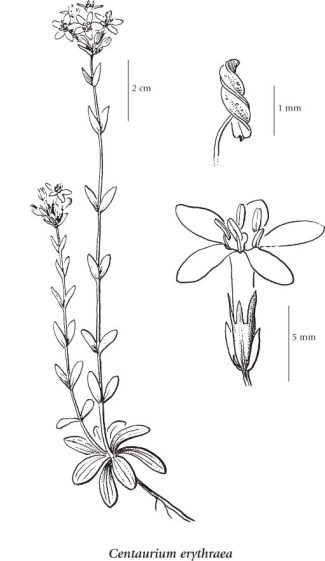Centaurium erythraea Rafn
common centaury (European centaury)
Gentianaceae (Gentian family)
Introduction to Vascular Plants
common centaury (European centaury)
Gentianaceae (Gentian family)
Introduction to Vascular Plants
Species Information
General:
Biennial herb from a short taproot; stems erect, many, simple to branched near the base, 10-50 cm tall.
Leaves:
Basal leaves forming a tuft, egg-shaped to oblanceolate, unstalked, 1.5-4 cm long, rounded at the tip, 3- to 5-veined; lower stem leaves similar to basal; upper stem leaves reduced, narrower, becoming more pointed at the tip.
Flowers:
Inflorescence of crowded, flat-topped, terminal clusters of unstalked or short-stalked flowers; corollas yellowish to pinkish-red, 1.1-1.6 cm long; calyces 4-6 mm long, lobes slender; anthers 1.5-2 mm long and conspicuously twisted; bracteoles 2, subtending the axillary flowers.
Fruits:
Capsules, cylindric, slender, thin-walled, 8-10 mm long; seeds irregularly angled, honeycombed, pitted.
Illustration

If more than one illustration is available for a species (e.g., separate illustrations were provided for two subspecies) then links to the separate images will be provided below. Note that individual subspecies or varietal illustrations are not always available.
Illustration Source: The Illustrated Flora of British Columbia
Habitat and Range
Mesic to dry roadsides, fields and waste places in the lowland zone; frequent in SW and SE BC (Kootenay Lake); introduced from Eurasia.Status Information
Synonyms
Synonyms and Alternate Names:
Centaurium minus auct. non Moench [misapplied]
Centaurium umbellatum
Erythraea centaurium auct.